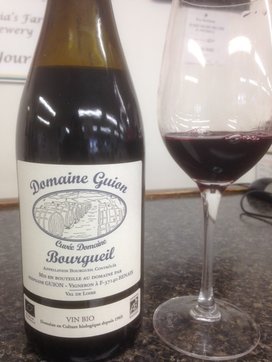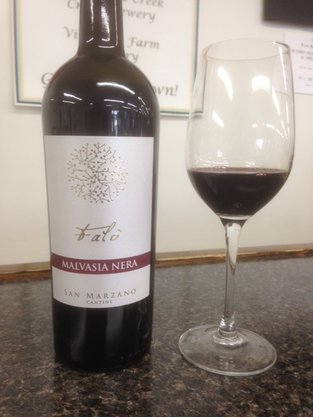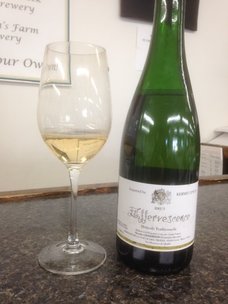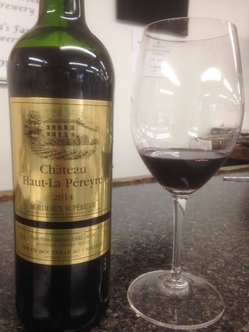 The move to more environmental conscious wines worldwide has made for a much healthier and diverse industry. Not only are the vineyards and lands around them better protected, it helps to bring out more distinct flavors and styles of wines, more choices for everyone. When all wineries are using the same 'recipe' for their grapes, fermenting with the same yeast strains, and aging their wines with the same tank or barrel program, it's should be no surprise that there is a same-ness that pervades through those wines. The downside is that the natural wines are more labor intensive, lots of time in the vineyards doing work by hand, and the pricing can be more prohibitive to people trying them on their own. More vineyards every year are making these conversions which is helping, as well as great importers striving to find the best possible interesection of craftmanship and affordability. This is one of the best deals we have found so far, a long established Biodynamic estate from the Loire that also run a self-sustaining farm whose wines epitomize the naturalist movement while still delivering value. This is the 'baby brother' to their 'Cuvee Prestige' bottling we have featured in the past, which featured their oldest vines and saw some time in barrel. This is made from their younger vines and aged in tanks to promote a more accessible style, but is equally charming in its own way and an even better price. Tart red cherry fruit and the classic Cabernet Franc prettiness come out at first, with darker red fruits evolving out as it opens. The fruit always stays on the savory side, the smells of the fruit still in the berry patch or on the vine, not the sweetened juice or jelly side. On the palate the wine has great weight for a wine at only 12%abv, which is a Godsend for people that find too many of the lower abv wines thin. The use of native yeasts bring out so much of the local complexity, and the minimalist process in the winery allows them to leave the wine unfiltered and very little SO2 to help maximize the flavor and texture. A pretty and 'pure' type of wine that has all sorts of food possibilities. If you have ever wanted to taste how the natural wines are different from others, this is the time to do it.
0 Comments
 Lesson #32,583 on how, even in a country with a wine history as lengthy as Italy, you should always look at things with a fresh eye. Puglia represents the 'heel' part of the Italian boot, and has 4 millenia of wine growing history as it was among the first areas settled by the Greeks. Modern civilization (the last 600 years counts as 'modern' here) has not been favorable as they are cut off from the interior of Italy by the Apennines mountains and much of the cultural prosperity of cities like Florence, Rome, and Naples since the Renaissance. Cities like Bari and Lecce aren't nearly the cultural and tourist attractions by comparison, so most of the world's attention has not been drawn to the wines made here. Many factors over the last few decades has seen growth and improvement in the Puglian wine industry, and those that are paying attention are finding many things to be excited about. The region is warmer than most of Italy, and the wines have a much spicier and forward character to them, so those that find most Italian reds too austere now have wines to explore. Zinfandel fans will want to take note as well since Primitivo is the parent to all those fantastic old vines found in California, and is the base for much of the wines here. Malvasia Nera is one of the partner grapes in the traditional Puglian field blend, playing the role somewhat like Petite Sirah would by adding darker fruit and some tannic structure. On its own, Malvasia Nera is fairly inky in the glass with lots of black fruit and lightly raisiny red grape aromas, showing lots of the warm climate with plenty of underlying sweet spice. On the palate there is lots of fruit without the sweeter jammy side that can often plague Californian Zinfandel, so the ripeness and complexity of the fruit comes through without leaving a sugary coating on your tongue or any heat from excessive alcohol. It IS still Italy, after all, so balance and food compatibility is still prized. As fun as this is on its own, matched with food is where this really shines, capable of working great with richer, sweeter sauces that can butt heads with more traditional wines. Think barbecue of almost any origin; vinegar based, tomato, rubs, Korean, etc. This and its regional friends are about as good as it gets.  We know many of you will be looking for a good bottle of bubbly for the upcoming Valentine's Day events (or did you forget?). While Champagne is the highest expression of sparkling wine in the world, it also carries a deservedly higher price tag. Those looking for great 'bang for the buck' bubbly are best served exploring some of the lesser known sparkling wine areas to find quality gems, even venture into some more experimental wines. Nicole Chanrion is a well regarded Beaujolais producer from the Kermit Lynch portfolio (whose Beaujolais represent the most important names in the region), and their Cote de Brouilly (@10 acres of 50+ year old Gamay)is on the very short list of best wines made in the appellation. The fruit that doesn't go into that benchmark wine goes here, a provocative 'Blanc de Noir' made in the Champagne method that really doesn't have a peer group with which to compare. There is no 'Cremant de Beaujolais' appellation the way there is a Cremant d'Alsace or Cremant de Jura to cover the sparkling wine industry in those regions. There really isn't anyone else on the market doing this type of wine, certainly not from Cru designated vineyards. So this wine stands alone, on its own merits, and is delicious. Clear and golden in the glass with the slightest hints of copper, this pours with a soft pillowy mousse that drops out fairly quickly and a crisp biscuity nose with lots of crisp white fruit and citrus. The gamay character comes through on the palate, showing the light high-toned red fruit and hints of savory of a proper Cru Beaujolais. Interestingly, the exceptionally low dosage makes perfect sense here as the grape's naturally soft texture and lower acidity greatly benefit from the extra cut in the finish to bring out all the tart apple tones. This is a great mass appeal sparkling wine for those who want a dry sparkler but don't have the palate or pocketbook for the more assertive 'true' Champagnes or Champagne emulators.  Bordeaux is rightfully viewed as one of the most important wine regions in the world, but it can sometimes be a victim of its own success. If the vintage isn't spectacular, the lack of international hype can make it difficult for even the reasonably priced wines to sell well. In researching information for this write-up, I found an on-line review stating '2014 is the 4th vintage in a row that is not a candidate for vintage of the century.' How DARE they! As if something supposed to happen once every 100 years should occur multiple times per decade or the region is officially in a rut. Bordeaux is an extremely large growing area, and there is charm and quality to be found every vintage for the 'drinker', even if the 'collector' isn't happy with the blue chip estates. Properties like Haut-La-Pereyre may not sit within the boundaries of the famous appellations, but their estate grown wine sees the same attention to detail that more known houses do for twice the price, making them one of the consistently great 'petits Chateaux' you can find for the money. The 2014 vintage was marked by a late, longer than usual ripening period for the grapes, which actually is helpful for Cabernet Sauvignon, so wines like this that have a fairly healthy chunk in the blend (45%) fared quite well. Loads of graphite and dark fruits emerge from the glass, developing some cocoa and slightly sweeter red fruit notes as it opens up. On the palate the fruit is still dark and primary but the texture is surprisingly ready to go without much in the way of hard tannins usually found in younger Bordeaux. This is also one of those wines that will 'put on weight' as it stays open, where the mouthfeel seemingly changes and gets fuller from one hour to the next. It's hard to quantify (and not everyone even believes it actually happens) but after 2-3 hours the palate definitely catches up with the early aromatics and brings the wine into great balance. A terrific value for the more old school Bordeaux fans that could do some evolving over a few years but doesn't need it as much as the more hyped vintages. |
The Best of the Best.We offering free tastings on these wines in the store every Thursday and Friday, and a 10% discount off the retail price through the duration of the day. Come on by and give them a try! Archives
July 2024
Categories |
Location |
|

 RSS Feed
RSS Feed